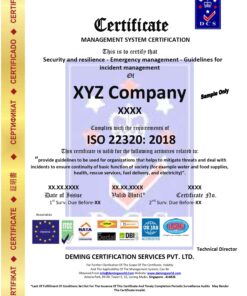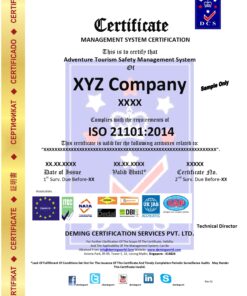ISO 45001:2018 Occupational Health And Safety (OHS)
Original price was: ₹15,000.00.₹12,000.00Current price is: ₹12,000.00.
ISO 45001:2018 Occupational Health And Safety (OHS)
ISO 45001:2018 is an international standard that specifies requirements for an occupational health and safety (OH&S) management system. It helps organizations to proactively improve their OH&S performance by preventing work-related injury and ill-health, as well as by providing a safe and healthy workplace.
Here are some key aspects and components of ISO 45001:2018:
- Scope: The standard applies to all types and sizes of organizations and is intended to be applicable to any organization regardless of its activities, products, or services.
- Leadership and Worker Participation: ISO 45001 emphasizes the importance of leadership and worker participation in the OH&S management system. Top management is required to demonstrate leadership and commitment to the management system, while workers should be actively involved in identifying hazards, assessing risks, and suggesting improvements.
- Planning: Organizations need to identify hazards, assess risks, and establish objectives and processes to improve OH&S performance. This includes setting measurable targets and implementing action plans to achieve them.
- Support and Resources: The standard requires organizations to provide the necessary resources, including competent workers, training, and infrastructure, to implement and maintain the OH&S management system effectively.
- Operation: This involves implementing the planned controls and processes to manage OH&S risks. It includes operational planning and control, emergency preparedness and response, and contractor management.
- Performance Evaluation: Organizations need to monitor, measure, and evaluate their OH&S performance against the planned objectives and targets. This involves conducting internal audits, management reviews, and taking corrective actions when necessary.
- Improvement: ISO 45001 encourages continuous improvement by identifying opportunities for improvement and implementing corrective actions to prevent recurrence of incidents and improve OH&S performance.
By implementing ISO 45001:2018, organizations can benefit in several ways:
- Reduced Workplace Incidents: By identifying hazards and implementing controls, organizations can reduce the risk of work-related injuries and illnesses.
- Legal Compliance: It helps organizations to comply with OH&S laws and regulations, reducing the risk of penalties and legal actions.
- Improved Reputation: Demonstrating a commitment to employee health and safety can enhance an organization’s reputation among stakeholders, including customers, suppliers, and the community.
- Cost Savings: Effective OH&S management can lead to reduced absenteeism, lower insurance premiums, and increased productivity, resulting in cost savings for the organization.
Overall, ISO 45001:2018 provides a framework for organizations to establish, implement, maintain, and continually improve an OH&S management system, thereby ensuring a safe and healthy workplace for all workers.
ISO 45001 is an ISO standard for management systems of occupational health and safety (OH&S), published in March 2018. The goal of ISO 45001 is the reduction of occupational injuries and diseases.[1]
The standard is based on OHSAS 18001, conventions and guidelines of the International Labour Organization including ILO OSH 2001, and national standards.[2][1] It includes elements that are additional to BS OHSAS 18001 (see below: ISO 45001 changes compared to OHSAS 18001:2007) which it is replacing over a three-year migration period from 2018 to 2021.









Reviews
There are no reviews yet.